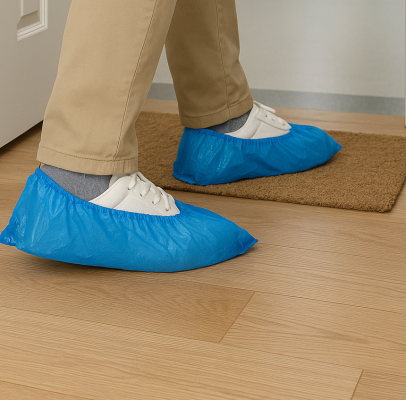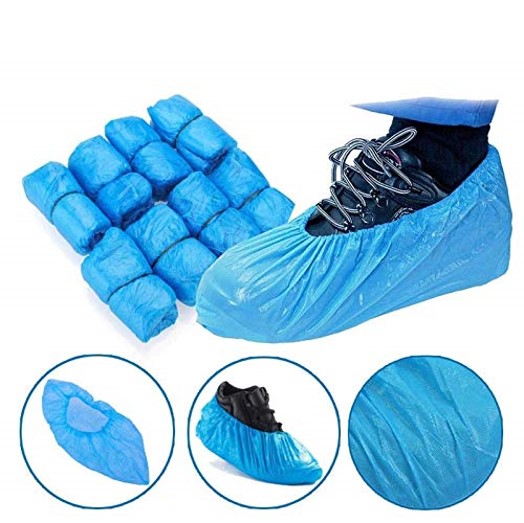Introduction
Shoe covers are an important accessory in various fields such as healthcare, cleanrooms, hotels, food processing factories, and even households. They help protect footwear from dirt, water, chemicals, and bacteria while maintaining a clean working environment.
Currently, there are many different types of shoe covers on the market, but the most popular are CPE, PE, non-woven fabric, and silicone. Each has unique characteristics regarding material, durability, water resistance, and cost. Therefore, to choose the right type of shoe cover, you need to clearly understand each one and its intended use.
In this article, we will analyze in detail the pros and cons of each type to help you make an informed decision.
Popular Types of Shoe Covers
CPE Shoe Covers (Chlorinated Polyethylene)
Advantages of CPE Shoe Covers
Outstanding Water Resistance
One of the strongest features of CPE shoe covers is their highly effective waterproof ability. Chlorinated polyethylene (CPE) has a thicker structure than regular PE, which completely prevents water and liquids from seeping into the shoe.
This is extremely important in environments such as hospitals, laboratories, food processing plants, or areas with high humidity. Thanks to this feature, CPE shoe covers help keep shoes dry and prevent bacteria or chemicals from contacting the shoe surface.
Greater Durability Compared to PE
Compared to cheaper types like PE, CPE shoe covers are thicker, meaning better resistance to tearing when putting on or walking.
Thanks to their sturdy structure, the product maintains its shape throughout usage, even during extended or frequent movement. This helps users save time and avoid changing covers multiple times a day.
Safe Anti-Slip Design
The surface of CPE shoe covers is often designed with patterns or light textures to increase friction with the floor. This helps reduce the risk of slipping, especially on tiles, wet floors, or slippery areas.
This feature not only ensures user safety but is also a mandatory factor in fields like healthcare, food production, or construction—where workplace safety is a top priority.
Reasonable Price
Although higher quality than PE, CPE shoe covers are still relatively affordable, especially when bought in bulk. This makes them an ideal choice for businesses, healthcare facilities, or production units that need to use large quantities daily while ensuring effective performance.
Compared to high-end types like silicone shoe covers, CPE offers great cost-performance, especially for one-time or short-term use.
Disadvantages of CPE Shoe Covers
Although more durable than PE, CPE shoe covers are still single-use and cannot be reused. In the long run, the cost of constantly replacing them may add up.
Since CPE plastic is difficult to decompose naturally, special environments are required for proper waste treatment. The disposal cost is also higher than usual.
Additionally, CPE shoe covers are not very elastic—pulling too hard may cause tearing, especially when used on large-sized shoes. So, when choosing, you should consider the fit and shoe size.
PE Shoe Covers (Polyethylene)
Advantages of PE Shoe Covers
Low Cost – Budget-Friendly for Businesses and Individuals
The most notable point of PE shoe covers is the low price. These are the cheapest shoe covers available today, suitable for organizations needing large quantities in a short period—such as hospitals, beauty clinics, hotels, industrial zones, or quarantine areas.
With a price of just a few hundred dong per piece, PE shoe covers significantly help institutions save budgets while maintaining basic hygiene. Especially when bought wholesale or by the carton, the discount rate becomes even more attractive.
Super Convenient and Flexible
PE shoe covers are thin and lightweight, easy to open, wear, and remove quickly. With an elastic band at the opening, the product fits snugly around the shoe without needing much adjustment during use.
Made from thin and light PE plastic, these covers are extremely lightweight—an advantage for transportation, storage, and warehousing.
Thus, this type is perfect for areas with high foot traffic, such as clinics, showrooms, exhibition rooms, or private homes when guests visit. Just a few seconds are enough to wear them—both convenient and time-saving.
Improved Decomposition with Biodegradable PE
Today, improved versions of PE shoe covers made from biodegradable plastic are available, helping reduce environmental impact compared to traditional PE plastic. Though not widely popular yet, this is a green trend chosen by environmentally conscious units.
If you need a product that’s both cheap and more eco-friendly, consider PE mixed with oxo-biodegradable additives or recycled plastic—a first step to reducing your company’s carbon footprint.
Disadvantages of PE Shoe Covers
The biggest downside of PE shoe covers is poor durability. Due to the thin plastic material, these covers easily tear, especially when walking on rough surfaces or using them for long durations.
Additionally, PE shoe covers offer only average water resistance—not as effective as CPE. In humid environments, PE might not provide enough protection and could allow water to seep through.
Also, similar to CPE, PE is hard to decompose and requires a special environment and proper treatment to reduce waste and protect the environment.
Non-Woven Fabric Shoe Covers
Advantages of Non-Woven Fabric Shoe Covers
Soft Fabric Material – Comfortable to Wear
The first outstanding point of non-woven fabric shoe covers is the comfort and softness when worn. Unlike plastic types (PE, CPE), this fabric has a soft, breathable surface and causes less discomfort, especially during long wear.
They don’t make crinkling noises when walking, making them ideal for quiet environments such as meeting rooms, libraries, nursing homes, or international schools. This is a big plus when receiving high-profile guests and needing to create a professional and courteous impression.
Breathable – No Foot Discomfort
Unlike plastic materials that are usually stuffy, non-woven fabric has an interwoven fiber structure that allows air circulation. This helps reduce foot sweat, dampness, or discomfort around the ankle when worn for long periods.
This breathability makes non-woven shoe covers an optimal choice for high-temperature environments or continuous use, such as spas, beauty salons, operating rooms with central air conditioning, or all-day events and conferences.
More Durable Than PE – Resistant to Tears and Punctures
Compared to low-cost types like PE, non-woven shoe covers are clearly thicker and more durable. The fabric doesn’t get brittle and is less affected by temperature changes or pressure from frequent movement.
Users can walk, stand for long periods, or go up and down stairs without worrying about tearing or slipping off. This is especially beneficial for employees in professional settings who need to maintain a neat and clean appearance throughout the day.
Professional Look and High Aesthetic Value
Non-woven fabric shoe covers usually have a more refined and sturdy appearance than plastic types. With soft colors like blue, white, gray, or green – they make workspaces look cleaner, more synchronized, and more professional.
That’s why many international hospitals, high-end clinics, aesthetic centers, yoga studios, or real estate showrooms choose non-woven fabric to impress customers right from the first step.
Reusable (Depending on Conditions) – More Cost-Efficient Than You Think
Though often classified as disposable, in clean and non-harsh environments, non-woven shoe covers can actually be reused several times a day, or even over several days if handled carefully.
Thanks to their high durability and good dust resistance, they can be reused for personal purposes such as indoor walking after cleaning, in spas or salons, or when receiving guests at home while maintaining hygiene.
This helps optimize costs for small units or individual users while still ensuring practical effectiveness.
Disadvantages of Non-Woven Fabric Shoe Covers
The biggest downside of this type is poor water resistance. Made from synthetic fibers, non-woven covers are not suitable for wet environments or contact with liquids.
Moreover, their price is higher than PE and CPE, so they are not ideal for those needing a cheap, daily-use solution.
Silicone Shoe Covers
Advantages of Silicone Shoe Covers
Reusable Many Times – Cost-Saving in the Long Run
Unlike single-use types like PE, CPE, or non-woven fabric, silicone shoe covers can be reused hundreds of times if cleaned and stored properly.
Made from premium silicone, they don’t tear, get brittle, or deform after repeated use. Users can wash and air-dry them quickly, saving significant costs in the long term—especially for individuals, office staff, or units that frequently enter clean environments.
100% Waterproof – Protect Shoes in All Weather
Silicone is 100% waterproof, protecting shoes from rain, mud, liquids, or mild chemicals. It’s the ideal choice during rainy seasons, when walking outdoors, or in wet, slippery areas.
With a design that hugs the entire shoe body and sole, silicone covers keep shoes clean, dry, and undamaged – especially useful for sports shoes, premium leather shoes, or hard-to-clean white shoes.
Anti-Slip Soles – Safe for Movement
A major plus of silicone shoe covers is their anti-slip soles with deep grooves or rubber spikes, enhancing grip on surfaces like tile, stairs, or wet roads.
This feature ensures safe and stable movement, preventing slips—especially important for the elderly, children, or those working in slippery environments like kitchens, hospitals, hotels…
Fashionable and Convenient Design – Carry It Anywhere
Silicone shoe covers come in modern styles and colors like gray, black, white, navy… suitable for various fashion preferences. Their compact, foldable design makes them easy to carry in bags, backpacks, or motorcycle trunks.
They’re popular among office workers, students, motorbike riders, or service staff who move frequently. In sudden rain, just a few seconds to put them on keeps your shoes protected—both convenient and stylish.
Flexible Fit – Suitable for Many Shoe Sizes
Silicone’s high elasticity allows it to snugly fit various shoe types: sneakers, high heels, leather shoes, sports shoes, and ankle boots. Products usually come in 3–4 common sizes (S, M, L, XL), helping users choose according to foot size and shoe type.
The snug ankle fit also blocks water, mud, or dust from entering from above—providing full protection that PE or fabric types can’t.
Easy to Clean, Quick to Dry – Always Ready to Use
Silicone doesn’t retain dirt long and is easy to clean with plain water or mild soap. After washing, just leave it in a ventilated area and it dries quickly without odor or mildew like fabrics.
This ensures the shoe covers stay clean and ready to use anytime. It’s especially suitable for meticulous users who care about hygiene and maintaining their shoes in top condition.
Sustainable & Eco-Friendly
Using reusable silicone covers greatly reduces disposable plastic waste from PE and CPE products. It’s the ideal choice for individuals, businesses, or organizations that value sustainability and environmental protection.
With long-lasting durability, just 1–2 pairs of silicone covers can replace hundreds of PE covers per year—saving money and showing responsibility toward nature.
Disadvantages of Silicone Shoe Covers
The biggest downside is the high price. Compared to disposable types like PE, CPE, or non-woven, silicone covers are significantly more expensive, making them less common for bulk use.
Also, while highly durable, silicone isn’t easy to biodegrade, so it’s not entirely eco-friendly either.

Which Type Should You Choose?
If You Need Low-Cost, Short-Term Use in Large Quantities
👉 Recommended: PE or CPE Shoe Covers
These are the most popular choices for hospitals, clinics, spas, factories, tourist sites, or event organizers – where there is high foot traffic and cost-saving is crucial.
- PE: The cheapest option, suitable for low-movement environments. However, it tears easily with heavy use.
- CPE: A higher-grade alternative to PE – thicker, better grip, basic water resistance. Ideal for more professional settings like international hospitals, showrooms, and high-end production areas.
🔎 Tip: If you want the lowest cost for one-time use, go with PE. If you want better durability and safety while still being affordable, choose CPE.
If You Want a Polished, Aesthetic, and Comfortable Experience
👉 Recommended: Non-Woven Fabric Shoe Covers
These are soft, quiet, and comfortable to wear for long periods—perfect for spa guests, meetings, massage rooms, upscale homestays, or high-end offices.
- High aesthetic appeal, soft colors, and fabric texture – creating a professional, friendly image, especially for VIP guests or premium settings.
- Good breathability, can be reused 2–3 times if properly maintained.
🔎 Tip: If you’re welcoming guests and want to maintain a professional, courteous appearance, go for non-woven fabric covers.
If You Need Complete Water Protection and Maximum Shoe Safety
👉 Recommended: Silicone Shoe Covers
This is the only type offering 100% waterproofing – protecting shoes from rain and mud during walks, work sites, or entry into industrial cleaning areas.
- Highly durable (hundreds of uses), anti-slip, tear-resistant.
- Foldable and portable, ideal for technicians, office workers, Grab drivers, delivery personnel, etc.
- Suitable for both individuals and sustainability-minded businesses.
🔎 Tip: If you need to reuse them multiple times and want to protect shoes from water and dirt—invest in durable, modern silicone.
If You Need Something for Home Use – Convenient & Versatile
👉 Suggestion: Combine PE + Non-Woven or Mini Silicone
- PE: Great for house cleaning or casual guests—doesn’t need to be durable.
- Non-Woven: Good for the elderly or children – soft, light, non-slip.
- Silicone: Best for walking in the yard, garden, or frequent use to save costs.
🔎 Tip: A household with diverse needs should be flexible: use PE for one-time events, non-woven for moderate reuse, and silicone when water protection or frequent walking is needed.
Conclusion
Choosing the Right Shoe Cover – A Small Decision That Makes a Big Difference
Although it’s a small item, a shoe cover plays a crucial role in maintaining hygiene, protecting footwear, and creating a professional impression in work or living spaces. Each type – PE, CPE, non-woven fabric, or silicone – has unique benefits suited for specific purposes, budgets, and usage needs.
- Need large quantity, low cost, single-use → PE/CPE is the smart choice.
- Want comfort and high aesthetics → Non-woven fabric is the best fit.
- Need water resistance and reusability → Invest in durable, modern silicone.
✅ Choosing the right shoe cover not only protects your beloved footwear but also reflects your attention to detail, thoughtfulness, and professionalism—either as an individual or a business.
Contact TM&DV 8688 COMPANY LIMITED
We specialize in supplying wholesale CPE and PE shoe covers – guaranteed quality – nationwide delivery.
👉 Personalized consultation for specific usage needs
👉 Attractive discounts for organizations and businesses
👉 Available stock – Fast delivery – Trusted and dedicated
📩 Contact us today for the best quote!
TM&DV 8688 COMPANY LIMITED – Small solutions, big impact for a professionally clean space.

